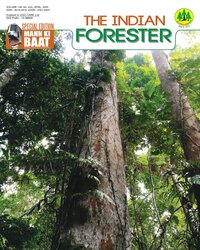Policy Interventions towards Sewage Management and Improvement in Water Quality of River Ganga
DOI:
https://doi.org/10.36808/if/2023/v149i4(A)/169910Keywords:
Wastewater Discharge, Sewage Management, River Ganga, Sewage Treatment Plants, Water Quality.Abstract
River Ganga is main sources of livelihood in Gangetic planes as well as holds special sacred value In Indian society. Discharge of untreated sewage in river system Is one of the important causes of water pollution, which has emerged as a major socio-economic issue. In 2016,361 TPD pollution load (in terms of BOD) was being discharged through 154 drains into the river. Till 2017-18, only 68 STP with treatment capacity of 1439 MLD were installed in Ganga front towns. By the dawn of year 2023, 139 STPs have been installed with treatment capacity of 2514 MLD, which shows an increase of 74% in treatment capacity as compared to that in 2017-18. Deployment of appropriate technologies for Interception, diversion and treatment of sewage resulted In reduction of pollution load discharge to river Ganga by 252.5 TPD through 516 drains In the year2022, which is a reduction of 30% in the load as compared to 2016. Noteworthy efforts are made for reuse of treated sewage with improved quality of treatment by adoption of stringent norms for treated sewage. In the 73rd episode of Mann ki Baat (MKB) on 31st January, 2021 Hon'ble Prime Minister (PM) of India underlined the issue of dirty water being used by the farmers for irrigation purpose and need for recycle and reuse of treated wastewater. Measures and Interventions to reduce the discharge of domestic wastewater entering Into the river have led to significant reduction in pollution. These efforts have ensued Improvement in water quality as well as overall health of the river. There has been a significant reduction in length of polluted stretches of the river.References
APHA(2017). Standard Methods for the Examination of Water and Wastewater (23rd ed.). Washington DC: American Public Health Association.
CPCB (2018). River Stretches for Restoration of Water Quality. New Delhi: Central Pollution Control Board, MoEFCC
CPHEEO (2013). Chapter 7: Recycling and reuse of sewage, in Manual on Sewerage and Sewage Treatment Systems (New Delhi: Ministry of Urban Development, Government of India).
Larsen T.A., and Gujer W. (2013). Implementation of Source Separation and Decentralization in Cities, Chapter 10 in Source Separation and Decentralization for Wastwater Management. London: IWA Publishing.
Libralato G., Ghirardini A.V., and Avezzu F. (2011). To centralize or to decentralize: an overview of the most recent trends in wastewater management. J. Environ. Manage. 94, 61-68. doi: 10.1016/j.jenvman.2011.07.010
Massoud M. A., Tarhini A., and Nasr J. A. (2009). Decentralized approaches to wastewater treatment and management: applicability in developing countries. J. Environ. Manage. 90, 652-659. doi: 10.1016/j.jenvman.2008.07.001
MoJS. (2020). National Framework on the Safe Reuse of Treated Water. Department of Water Resources, River Development & Ganga Rejuvenation, National Mission for Clean Ganga, Ministry of Jal Shakti, Government of India
MoWR. (2017). STPs Under Ganga Action Plan. Ministry of Water Resources (MoWR), River Development and Ganga Rejuvenation, New Delhi, India
NITI Ayog, Government of India (2022). White Paper on Urban Waste Water Scenario in India. NITI Ayog
Parkinson J., and Tayler K. (2003). Decentralized wastewater management in peri-urban areas in low-income countries. Environ. Urban. 15. doi: 10.1177/095624780301500119
Rath M., Schellenberg T, Rajan P. and Singhal G. (2020). Decentralized Wastewater and Fecal Sludge Management: Case Studies from India. ADBI Development Case Study No. 2020-4 (September).
Schellenberg T., Subramanian V., Ganeshan G. Tompkins D., Pradeep R. (2020). Wastewater Discharge Standards in the Evolving Context of Urban Sustainability-The Case of India. Frontiers in Environmental Science. 8. 10.3389/fenvs.2020.00030.
Trivedi R.C. (2010). Water quality of the Ganga River-an overview. Aquatic Ecosystem Health & Management, 13(4): 347-351.
Vidyarthi A.K., Ahmad F., Ranjan P., Dua C. and Parashar S. (2020). Assessment of Water Quality of Ganga River Stretch from Kanpurto Deori Ghat, Pollution Research, 39: S50-S54.
Downloads
Downloads
Published
How to Cite
Issue
Section
License
Unless otherwise stated, copyright or similar rights in all materials presented on the site, including graphical images, are owned by Indian Forester.





